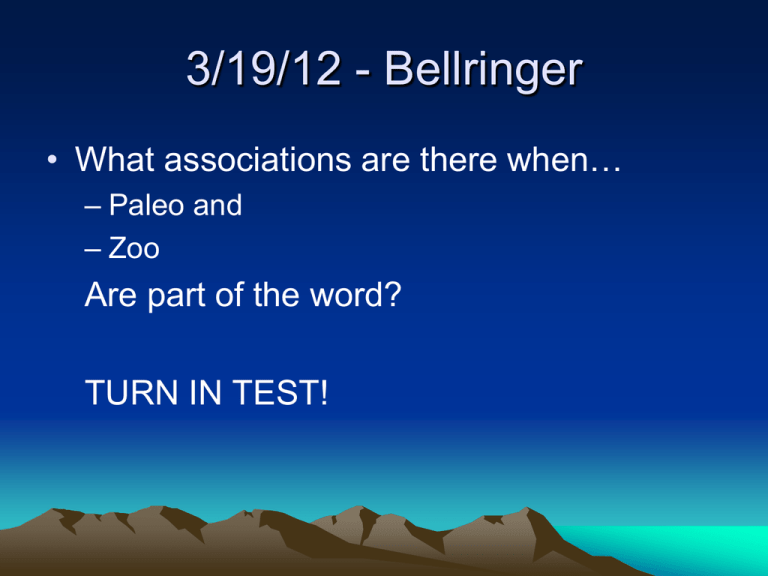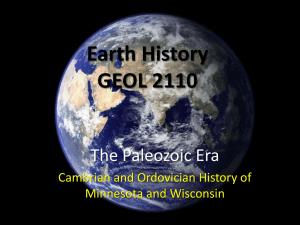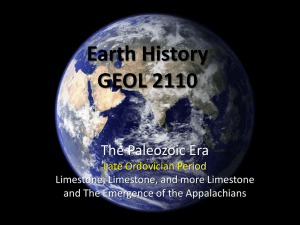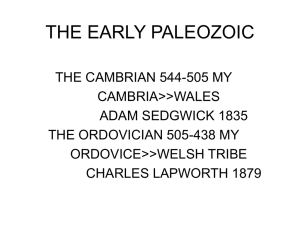Chapter 23 Paleozoic, Mesozoic, & Cenozoic Eras
advertisement

3/19/12 - Bellringer • What associations are there when… – Paleo and – Zoo Are part of the word? TURN IN TEST! Timeline of ALL TIME • Review • http://www.johnkyrk.com/evolution.html Chapter 23 Paleozoic, Mesozoic, & Cenozoic Eras 23.1 – Paleozoic Era Phanerozoic Eon • "visible life." • 542 million years ago to the present • Consists of three eras – Paleozoic = "ancient life" (542-251 million years ago) – Mesozoic = "middle life" (251-65.5 million years ago) – Cenozoic = "recent life" (65.5 million years ago to the present) http://higheredbcs.wiley.com/legacy/college/levin/0471697435/chap_tut/chaps/chapter10-01.html http://www.geol.umd.edu/~tholtz/G102/102lpal1.htm Paleozoic Era – Early Paleozoic = Cambrian, Ordovician and Silurian periods – Late Paleozoic= Devonian, Mississippian, Pennsylvanian, and Permian periods • Long periods of sedimentation and mountain building. http://higheredbcs.wiley.com/legacy/college/levin/0471697435/chap_tut/chaps/chapter10-01.html Paleogeography • Ancient geographic setting of an area defined by breakup of supercontinent Rodinia • Multicellular life evolved with increasing complexity http://higheredbcs.wiley.com/legacy/college/levin/0471697435/chap_tut/chaps/chapter10-01.html Passive Margin • No tectonic activity along the edge of a continent • Laurentia split from Rodinia – Located near equator – Covered by shallow tropical sea – No mountain ranges forming – Completely surrounded by passive margins Shoreline deposition • Evidence of sea level changes • Tides wash sand and sediment ashore – forms sandstone • Deposit clay offshore – Forms shale • Calcium carbonate from sea water and as organisms die, falls to seafloor – Forms limestone Transgression • Movement of shore-line inland as sea level rises – As level rises & falls, deposition shifts • Rise in water level, causes water to move inland – Deep water deposits overlying shallow water deposits in vertical rock sequences Regression • Sea level falls – Shore moves out to the sea • Shallow water deposits overlie deep water deposits in vertical rock sequences • Evidence is found in stacked sequence of limestone-shale-sandstone Evaporites • Rocks that have crystallized out of water that is saturated with dissolved minerals • Associated with fossilized reefs – Reefs are made from carbonate skeletons of organisms – Form in long, linear mounds parallel to continents or islands – Absorb energy from waves that crash against them Glaciation • Sea level transgressed and regressed over 50 times during late Paleozoic • Reasons for change: – Climate and glaciation cycles – Crustal subsidence and uplift – Sedimentation rates – Plate motions In-class Assignment/Homework • Transgression/Regression Worksheet 23.1 Notes continued Mountain Building • During Ordovician Period, Laurentia collided with Taconic Island Arc – Mountains began to rise in what is now northeastern North America – Event known as Taconic Orogeny Taconic Mountains • Added new land and an active volcanic zone along eastern margin of Laurentia – Evidence found in New York’s Taconic Mountains http://geoscape.nrcan.gc.ca/toronto/escarp_e.php Deformation • During Silurian Period, Laurentia collided with another landmass • Caused folds, faults and igneous intrusions to already deformed rocks Ouachita Orogeny • During Carbonifierous Period southeastern Laurentia collided with Gondwana – Gondwana = large landmass that eventually formed southern continents • Formed Ouachita Mountains for Arkansas and Oklahoma http://www.rockhoundingar.com/geology/ouamtns.html Ouachita Orogeny • Caused crust to uplift inland as far as present-day Colorado • Formed ancestral Rockies Mountains http://jan.ucc.nau.edu/~rcb7/Ancestral_Rockies.jpg Alleghenian Orogeny • Gondwana continued to push against Laurentia • Appalachian Mountains began to form – Quite possibly taller than Himalayans when formed • Last mountain-building event of Paleozoic – Leads to formation of Pangaea In-class Assignment/Homework • 23.1 Study Guide – #2 = Laurasia = Laurentia – Skip #8, 15, 16 – #6 = 650 – #13 & 14 = 649 – #17 & 18 = 650 23.1 Notes, part C Paleozoic Life • Multicellular organisms went through extensive diversification • First appearance of organisms with hard parts http://higheredbcs.wiley.com/legacy/college/levin/0471697435/chap_tut/images/nw0237ann.jpg Cambrian explosion • Geologically rapid diversification of a large collection of organisms in the Cambrian fossil record – Burgess Shale • Spectacular array of fossil organisms with hard parts Ordovician extinction • More than half of marine groups that appeared during Cambrian became extinct • Evidence of glacial deposits found – When water freezes, sea level drops Ordovician extinction • Most marine animals live in shallow waters on continental shelves • When sea level is high = many places for animals to live • During regression, continental shelves become too narrow for life to survive Devonian Period • Following Ordovician, marine life recovered and new species evolved – Tremendous diversification of vertebrates (animals with backbones) – Fish and first appearance of tetrapods on land • Another extinction takes place Devonian extinction • Eliminates approximately 50% of marine groups • Caused by global cooling • Evidence of glaciers on some continents http://universe-review.ca/I10-35-extinction.jpg Plant Life • Ordovician and Devonian extinctions had little effect on land organisms • Simple land plants begin to appear • First plants with seeds diversified – Seeds contain own moisture and food source – Made them more enabled to survive change in environments Permian Period • Largest mass extinction occurred • Affected both marine and terrestrial organisms – Eliminated nearly 95% of marine groups – More than 65% of amphibians and 1/3 of insects did not survive Permian Extinction • How did it happen? • Many causes – Dramatic drop in sea level from Pangaea formation draining shallow seas – Extreme volcanism – Low atmospheric oxygen levels – A Meteorite impact In-class Assignment/Homework











